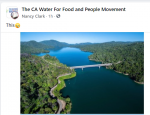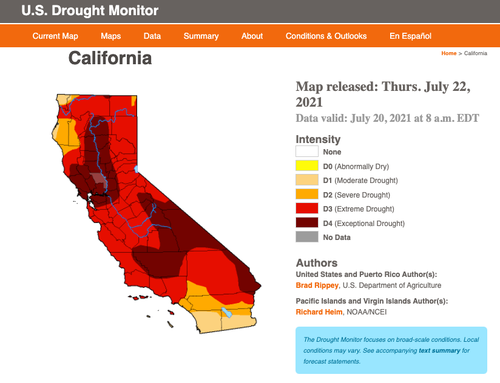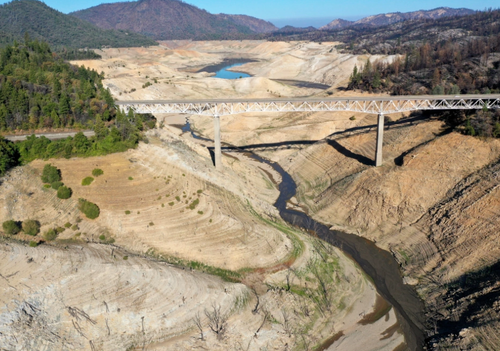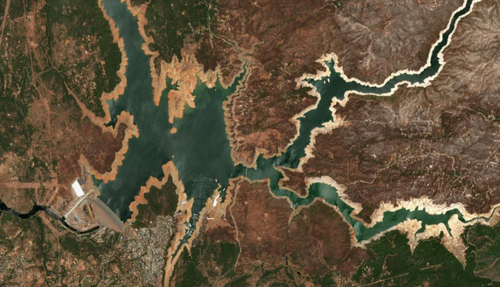marsh
On TB every waking moment
Zerohedge
ZeroHedge - On a long enough timeline, the survival rate for everyone drops to zero
State Of Emergency At Lake Powell: Fears Of Hydroelectric And Water Shutoffs Mount
Authored by Mike Shedlock via MishTalk.com,
Lake Powell is getting an emergency release of water from upstream reservoirs. Water levels have approached a critical level.

Grim Future for Lake Powell
Water levels in Lake Powell are at record lows. If levels drop much further, hydroelectric turbines will cease to run.
The lake supplies water to 30 million people and irrigation of 5 million acres.
Emergency Declared
Gizmodo reports Officials Pull ‘Emergency Lever’ as Lake Powell Plunges Toward Dangerous New Low.
The Bureau of Reclamation began emergency water releases from reservoirs upstream in the Colorado River this week in an effort to keep Lake Powell, the country’s second-largest reservoir, full enough to continue to generate hydroelectric power.
The reservoir is projected to hit a critical new low of (1,075 meters) by April 2022, just 25 feet (7.6 meters) above the level at which hydropower can no longer be generated. The Bureau of Reclamation said the emergency releases from reservoirs upstream—which includes the Flaming Gorge Reservoir in Wyoming, the Blue Mesa Reservoir in Colorado, and the Navajo Reservoir in New Mexico—will continue until December and could last into next year.
The low water levels in Lake Powell aren’t just a problem for the industries and cities that rely on the water in the reservoir. It’s also an issue for the Glen Canyon Dam, a 1,320-megawatt hydroelectric power plant that produces electricity distributed to customers in seven different states. The Bureau of Reclamation said the releases from Flaming Gorge, which will start this month, will increase the water level 50 cubic feet (1.4 cubic meters) per second every day, and will last until July 23.
Glen Canyon Dam isn’t the only hydropower plant facing trouble with the West’s megadrought. The water level at Lake Oroville, California’s largest reservoir, has dipped so low this summer during the state’s searing heat that officials say they may have to shut off the hydropower plant there.
Cascading EmergencyLake Mead, another large reservoir downstream on the river, fell to its lowest levels in history in June. Officials are planning to declare water shortage conditions in August that would trigger water-saving measures in surrounding states. If the water levels fall below 3,525 feet in Lake Powell it could “potentially lead to seven-state litigation, which we’ve never seen before on [the] Colorado River,” Amy Ostdiek, deputy section chief of the federal, interstate and water information section of the Colorado Water Conservation Board, told Colorado Public Radio. “Which would create a lot of uncertainty. It would probably be a very long, drawn out process.”
Think of Lake Mead and Lake Powell as one big reservoir separated by the Grand Canyon. Both are on the Colorado River.
Lake Mead is endangered but Lake Powell cannot help because it's endangered too.
Lake Powell needs help from further upstream reservoirs. But what are the upstream reservoirs going to do?
Lake Powell is Doomed
The Salt Lake Tribune reports Lake Powell could become a ‘dead pool’ as climate change, political wars and unabated growth drain its waters
“Lake Powell is doomed,” says Gary Wockner, an author and scientist who heads the group Save the Colorado. “The sooner we accept that inevitability, the sooner we will find a permanent solution.”
Under a 1922 interstate compact, the river’s water is evenly divided between its Upper Basin (Wyoming, Colorado, New Mexico and Utah) and Lower Basin (Arizona, Nevada and California) states. Each basin is supposed to receive 7.5 million acre-feet, with Mexico getting 1.5 million. But, in reality, far less water than that has been available during the past two decades, while the Lower Basin states have been pulling more than its allocated share.
Even with the Upper Basin taking far less than its share, the level of Utah’s Lake Powell, which stores runoff originating in these upriver states, has been steadily dropping. Today, its surface sits at 3,575 feet above sea level, holding 10 million acre-feet of water, about half as much as it did in 2000, when its elevation was about 100 feet higher. Four of the 10 lowest-runoff years have occurred during this time period.
Water RightsEven amid all this uncertainty, Upper Basin states are pursuing more diversions, which could funnel up to 300,000 acre-feet from Powell.One of those projects, Utah’s Lake Powell pipeline to St. George, would siphon off 86,000 acre-feet.
Water rights differ greatly between the Western and Eastern US. The East is primarily governed by Riparian Rights and the West by Appropriative Rights.
In California, Water Rights Law is a blend.
A riparian right entitles the landowner to use a correlative share of the water flowing past his or her property. Riparian rights do not require permits, licenses, or government approval, but they apply only to the water which would naturally flow in the stream. Riparian rights do not entitle a water use to divert water to storage in a reservoir for use in the dry season or to use water on land outside of the watershed. Riparian rights remain with the property when it changes hands, although parcels severed from the adjacent water source generally lose their right to the water.
Water right law was set on a different course in 1849, when thousands of fortune seekers flocked to California following the discovery of gold. Water development proceeded on a scale never before witnessed in the United States as these “49ers” built extensive networks of flumes and waterways to work their claims. The water carried in these systems often had to be transported far from the original river or stream. The self-governing, maverick miners applied the same “finders-keepers” rule to water that they did to their mining claims. It belonged to the first miner to assert ownership.
To stake their water claims, the miners developed a system of “posting notice” which signaled the birth of today’s appropriative right system. It allowed others to divert available water from the same river or stream, but their rights existed within a hierarchy of priorities. This “first in time, first in right” principal became an important feature of modern water right law.
In 1850, California entered the Union as the thirty-first state. One of the first actions taken by its lawmakers was to adopt the common law of riparian rights. One year later, the Legislature recognized the appropriative right system as having the force of law. The appropriative right system continued to increase in use as agriculture and population centers blossomed and ownership of land was transferred into private hands.
100 Feet Down 25 Feet to GoThe conflicting nature of California’s dual water right system prompted numerous legal disputes. Unlike appropriative users, riparian right holders were not required to put water to reasonable and beneficial use. This clash of rights eventually resulted in a constitutional amendment (Article X, Section 2 of the California Constitution) that requires all use of water to be “reasonable and beneficial.” These “beneficial uses” have commonly included municipal and industrial uses, irrigation, hydroelectric generation, and livestock watering. More recently, the concept has been broadened to include recreational use, fish and wildlife protection, and enhancement and aesthetic enjoyment.
With the above water rights understanding out of the way, let's return to water levels.
The water level of Lake Powell is down 100 feet since 2000. In another 25 feet, the turbines shut down.
Yet more water projects in the upper basin are planned. This is allowed because the upper basin is not using its fair share as determined in a 1922 decree.
California, in the Lower Basin is using more than its fair share.
First come first serve and California's hybrid is going to meet reality: There is not enough water so something has to give.
Where this is Headed
It's certain this is headed to the US Supreme Court as that is the only way state-to-state conflicts are resolved.
At least 7 states are involved in Colorado River claims, and disputes are rising.
On July 11, I noted Mississippi Claims Memphis is Stealing its Groundwater, Supreme Court to Decide
That's the first of many water issues that will head the Supreme Court's way.










